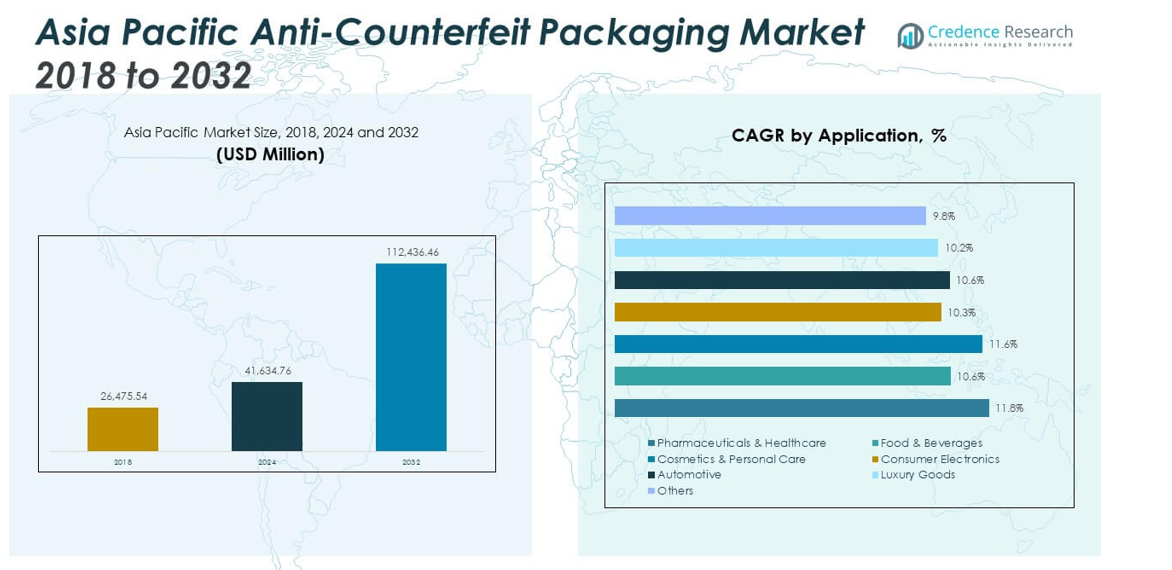CHAPTER NO. 1 : GENESIS OF THE MARKET
1.1 Market Prelude – Introduction & Scope
1.2 The Big Picture – Objectives & Vision
1.3 Strategic Edge – Unique Value Proposition
1.4 Stakeholder Compass – Key Beneficiaries
CHAPTER NO. 2 : EXECUTIVE LENS
2.1 Pulse of the Industry – Market Snapshot
2.2 Growth Arc – Revenue Projections (USD Million)
2.3. Premium Insights – Based on Primary Interviews
CHAPTER NO. 3 : ASIA PACIFIC ANTI-COUNTERFEIT PACKAGING MARKET FORCES & INDUSTRY PULSE
3.1 Foundations of Change – Market Overview
3.2 Catalysts of Expansion – Key Market Drivers
3.2.1 Momentum Boosters – Growth Triggers
3.2.2 Innovation Fuel – Disruptive Technologies
3.3 Headwinds & Crosswinds – Market Restraints
3.3.1 Regulatory Tides – Compliance Challenges
3.3.2 Economic Frictions – Inflationary Pressures
3.4 Untapped Horizons – Growth Potential & Opportunities
3.5 Strategic Navigation – Industry Frameworks
3.5.1 Market Equilibrium – Porter’s Five Forces
3.5.2 Ecosystem Dynamics – Value Chain Analysis
3.5.3 Macro Forces – PESTEL Breakdown
3.6 Price Trend Analysis
3.6.1 Regional Price Trend
3.6.2 Price Trend by product
CHAPTER NO. 4 : KEY INVESTMENT EPICENTER
4.1 Regional Goldmines – High-Growth Geographies
4.2 Product Frontiers – Lucrative Product Categories
4.3 Application Sweet Spots – Emerging Demand Segments
CHAPTER NO. 5: REVENUE TRAJECTORY & WEALTH MAPPING
5.1 Momentum Metrics – Forecast & Growth Curves
5.2 Regional Revenue Footprint – Market Share Insights
5.3 Segmental Wealth Flow – Packaging Type & Application Revenue
CHAPTER NO. 6 : TRADE & COMMERCE ANALYSIS
6.1. Import Analysis by Region
6.1.1. Asia Pacific Anti-Counterfeit Packaging Market Import Revenue By Region
6.2. Export Analysis by Region
6.2.1. Asia Pacific Anti-Counterfeit Packaging Market Export Revenue By Region
CHAPTER NO. 7 : COMPETITION ANALYSIS
7.1. Company Market Share Analysis
7.1.1. Asia Pacific Anti-Counterfeit Packaging Market: Company Market Share
7.2. Asia Pacific Anti-Counterfeit Packaging Market Company Revenue Market Share
7.3. Strategic Developments
7.3.1. Acquisitions & Mergers
7.3.2. New Product Launch
7.3.3. Regional Expansion
7.4. Competitive Dashboard
7.5. Company Assessment Metrics, 2024
CHAPTER NO. 8 : ASIA PACIFIC ANTI-COUNTERFEIT PACKAGING MARKET – BY PACKAGING TYPE SEGMENT ANALYSIS
8.1. Asia Pacific Anti-Counterfeit Packaging Market Overview by Packaging Type Segment
8.1.1. Asia Pacific Anti-Counterfeit Packaging Market Revenue Share By Packaging Type
8.2. Labels
8.3. Flexible Packaging
8.4. Rigid Packaging
8.5. Seals & Tapes
8.6. Shrink Sleeves
8.7. Cartons
CHAPTER NO. 9 : ASIA PACIFIC ANTI-COUNTERFEIT PACKAGING MARKET – BY APPLICATION SEGMENT ANALYSIS
9.1. Asia Pacific Anti-Counterfeit Packaging Market Overview by Application Segment
9.1.1. Asia Pacific Anti-Counterfeit Packaging Market Revenue Share By Application
9.2. Pharmaceuticals & Healthcare
9.3. Food & Beverages
9.4. Cosmetics & Personal Care
9.5. Consumer Electronics
9.6. Automotive
9.7. Luxury Goods
9.8. Others
CHAPTER NO. 10 : ASIA PACIFIC ANTI-COUNTERFEIT PACKAGING MARKET – BY TECHNOLOGY SEGMENT ANALYSIS
10.1. Asia Pacific Anti-Counterfeit Packaging Market Overview by Technology Segment
10.1.1. Asia Pacific Anti-Counterfeit Packaging Market Revenue Share By Technology
10.2. Holograms
10.3. RFID/NFC
10.4. Barcode & Serialization
10.5. QR Codes
10.6. Security Inks & Coatings
10.7. Tamper-Evident Features
10.8. Forensic Markers
10.9. Digital Watermarks
CHAPTER NO. 11 : ASIA PACIFIC ANTI-COUNTERFEIT PACKAGING MARKET – COUNTRY ANALYSIS
11.1. Asia Pacific Anti-Counterfeit Packaging Market Overview by Country Segment
11.1.1. Asia Pacific Anti-Counterfeit Packaging Market Revenue Share By Region
11.2. Asia Pacific
11.2.1. Asia Pacific Anti-Counterfeit Packaging Market Revenue By Country
11.2.2. Packaging Type
11.2.3. Asia Pacific Anti-Counterfeit Packaging Market Revenue By Packaging Type
11.2.4. Application
11.2.5. Asia Pacific Anti-Counterfeit Packaging Market Revenue By Application
11.2.5. Technology
11.2.7. Asia Pacific Anti-Counterfeit Packaging Market Revenue By Technology
11.3. China
11.4. Japan
11.5. South Korea
11.6. India
11.7. Australia
11.8. Southeast Asia
11.9. Rest of Asia Pacific
CHAPTER NO. 12 : COMPANY PROFILES
12.1. Avery Dennison
12.1.1. Company Overview
12.1.2. Product Portfolio
12.1.3. Financial Overview
12.1.4. Recent Developments
12.1.5. Growth Strategy
12.1.6. SWOT Analysis
12.2. CCL Industries
12.3. 3M
12.4. DuPont
12.5. Zebra Technologies
12.6. SICPA
12.7. Applied DNA Sciences
12.8. AlpVision
12.9. Constantia Flexibles
12.10. Antares Vision
12.11. Brady Corporation










